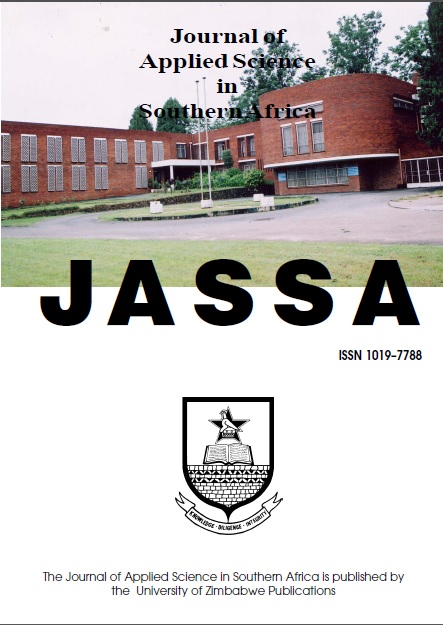
JOURNAL OF APPLIED SCIENCE IN SOUTHERN AFRICA
University of Zimbabwe Publications
DOI: 10.5897/UJ-JASSA
Email: uzpub@admin.uz.ac.zw
New sampling method on nickel sheet-cathodes, manufactured by the Outokompu process
DOI: 10.5897/UJ-JASSA.17.004.2 | Article Number: 1E4A933A4 | Vol.22 (2) - December 2016
Authors: Wakandigara A. , Mafodya J. and Musarandoga S.
Keywords: Nickel sheet-cathode, Distribution pattern, Sampling method
Obtaining a representative sample from electrometallurgically- generated nickel sheet-cathodes, to determine concentrations of trace elements, has always been a challenge, due to the heterogeneous distribution of such impurities in the sheet. Knowledge about the distribution patterns of impurities in the nickel cathodes is scanty and studies concerning appropriate sampling methods for nickel sheet-cathodes are not extensive.
An investigation was done on the distribution patterns of cobalt, copper, iron and zinc in nickel cathodes and various sampling methods were tested on an isolated-and-profiled nickel cathode. It was observed that the distribution of the four above-mentioned impurities did not follow a consistent pattern and in all cases random sampling produced more accurate results than the current sampling methods. A new random-based sampling technique was then designed.
EMPRESS NICKEL REFINERY. (2010). Sampling of nickel cathodes. Standard Work Procedure. SWP45: 1-5.
GUY R.D., RAMALEY L. AND WENTZELL P.D. (1998). An experiment in the sampling of solids for chemical analysis. Journal of Chemical Education. 75(8): 1028-1033.
GY P. (2004). Sampling of discrete materials – a new introduction to the theory of sampling I. Qualitative approach. Chemometrics and Intelligent Laboratory Systems. 74: 7-24.
GY P.M. (1995). Introduction to the theory of sampling I. Heterogeneity of a population of uncorrelated units. Trends in Analytical Chemistry. 42(2): 67-76.
ISO7156:1991(E). (1991) Refined Nickel – Sampling. International Standard. KATEMAN G. (1988). Sampling Theory. Chemometrics and Intelligent Laboratory Systems. 4: 187-199.
KRATOCHVIL B. AND TAYLOR J.K. (1981). Sampling for chemical analysis. Analytical Chemistry. 53(8): 924A-938A.
MÄNIKEN T., FAGERLUND K., ANJALA Y. AND ROSENBACK L. (2005). Outokumpu’s technologies for efficient and environmentally sound nickel production. COM 2005: Nickel and Cobalt. August 21 – 24, Galgary, Alberta, Canada.
MINKKINEN P. (2004). Practical applications of sampling theory. Chemometrics and Intelligent Laboratory Systems. 74: 85-94.
PANACEK E.A. AND THOMPSON C.B. (2007). Sampling Methods: Selecting your subjects. Air Medical Journal. 26(2): 75-78.
PAVLIDES A.G. (2008). Developments in cobalt and nickel electrowinning technology. Anglo American Mining Conference. Johannesburg. pp11.
PETERSEN L. AND ESBENSEN K.H. (2005). Representative process sampling for reliable data analysis – a tutorial. Journal of Chemometrics. 19: 625-647.
PETERSEN L., MINKKINEN P. AND ESBENSEN K.H. (2005). Representative sampling for reliable data analysis: Theory of sampling. Chemometrics and Intelligent Laboratory Systems. 77: 261-277.
SMITH P.L. (2004). Audit and assessment of sampling systems. Chemometrics and Intelligent Laboratory Systems. 74: 225-230
